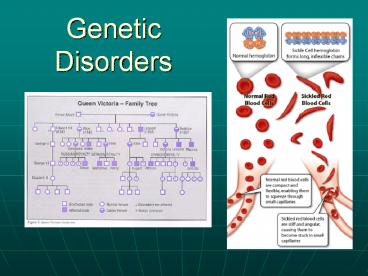Genetic Disorders - PowerPoint PPT Presentation
Title:
Genetic Disorders
Description:
Genetic Disorders Review Parents pass traits to their offspring through their genes. ... Diseases Scientists have discovered that some medical disorders are genetic. – PowerPoint PPT presentation
Number of Views:242
Avg rating:3.0/5.0
Title: Genetic Disorders
1
Genetic Disorders
2
Review
- Parents pass traits to their offspring through
their genes. - Genes are located on bigger structures called
chromosomes each person has 46 of these, which
are joined into 23 pairs. - Each parent contributes one-half of each pair.
- It's how those genes work together that makes you
unique!
3
Diseases
- Scientists have discovered that some medical
disorders are genetic. - Problems arise when the disease gene is dominant
or when the same recessive disease gene is
present on both chromosomes in a pair.
4
- If a person carries the dominant gene for a
disease, he or she will usually have the disease - Diseases caused by a dominant gene include
- Marfan syndrome (a connective tissue disorder).
People with Marfan have an increased risk that
their aorta will enlarge and eventually rupture. - Huntington disease (a degenerative disease of
the nervous system).
5
Carriers
- People who have one recessive gene for a disease
are called carriers, and they don't usually have
the disease because they have one normal,
dominant gene. In other words, their genotype
for this trait is heterozygous. - However, when two carriers have a child together
the child has a 1 in 4 (25) chance of getting
the disease gene from both parents, which results
in the child having the disease.
6
Examples of Recessive Disorders
- Disorders that occur when recessive disease genes
from both parents come together in a child.
(homozygous recessive) - Cystic fibrosis (a lung disease)
- Sickle cell anemia (a blood disease)
- Tay-Sachs disease (which causes nervous system
problems)
7
If both parents are carriers (heterozygous) what
is the probability that they will pass this
recessive gene to their child? Complete a
Punnett Square to model the probabilities. N
normal red blood cell n sickle cell.
8
X-linked Genetic Disorders
- You have 23 pairs of genes and one of the pairs
determines what gender you are male or female - Boys XY Girls XX
- Some recessive genes are carried only on the X
chromosome, which means that usually only males
can develop the disease because they have only
one X chromosome. - Females have two X chromosomes, so they would
need to inherit two copies of the recessive gene
to get the disease.
9
X-linked disorders
- X-linked disorders include color blindness and
the bleeding disorder hemophilia. - Hemophilia is a genetic disorder in which a
person's blood does not clot properly. - A person who has hemophilia has a tendency to
bleed excessively. - The Royal Courts of Europe provide an interesting
case study of hemophilia in a family tree.
10
The Royal Disease
- Normally, hemophilia is quite rare.
- But because royal families usually married people
from other royal families, there was more of a
chance that children would inherit the gene for
this trait. - Queen Victoria of England (1837-1901) was a
carrier of the hemophilia gene and subsequently
passed the disease on to several royal families.
11
- Two of Queen Victoria's daughters, Alice and
Beatrice, were carriers of hemophilia. - They passed the disease on to the Spanish, German
and Russian royal families, ensuring that the
disease would be present in future generations.
12
(No Transcript)
13
Genetic Mutation
- Some genetic disorders are caused by mutations in
genes. - Brainpop! Genetic Mutation































